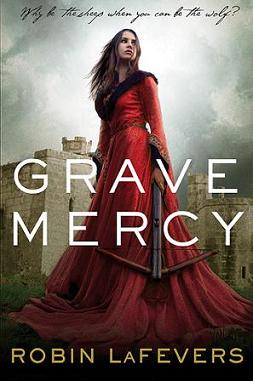
When I attended Catholic school, the concept of assassin nuns never crossed my mind. Although I always did wonder if my fave second grade teacher, Sister Joyce Maria, had a hidden past or a secret identity. Don't laugh, just check out the true story of Martha Leiker, a former nun turned CIA agent. Take that, James Bond!
As for Grave Mercy by Robin LaFevers, the first book in her new His Fair Assassin YA trilogy, which is about assassin nuns, leaves me "dying" for more. I'm a huge fan of LaFevers middle grade series Theodosia Throckmorton, which is set in Edwardian England.
Was LaFevers worried how Theo fans would react to her new series? Sure. But she need not to worry because she hits it out of the ballpark with Grave Mercy. About making the leap into YA, LaFevers says:
"One of my concerns for my Theodosia fans was that many of them are under twelve and I feel this book is for readers fourteen and up. But in addition to that, the books are vastly different in tone and depth and subject matter. The Theodosia books are a lot more humorous with more of a light-hearted romp feel to them. Grave Mercy is almost 180 degrees different from that -- it is dark, and full of betrayals and death and unbridled ambition and sexual tension."
Indeed it is! Grave Mercy is set during the late 15th century in Brittany, a historic and cultural region located in northwest France. At the time of the story, the area is ruled by the Brenton nobility whose leader, Anne, was the last duchess of Brittany. Anne, a young teen, was forced to seek a husband in order to keep control of Breton's independence from France... but her troubles resulted in war and human casualties.
In between other projects, LaFevers worked on her novel five or six years. She conducted extensive research on Brittany's history, the formation of its political state, its power struggle with France, the lives of French nobles and the court. The story is compelling and had me turning the pages. Frankly, I didn't want it end.

At the heart of Grave Mercy is seventeen-year-old Ismae Rienne who, herself, is forced into an abusive arranged marriage. Fortunately, she's rescued from her fate by the nuns at the convent of St. Mortain.
In exchange for her freedom, Ismae strikes a bargain with the nuns -- she will train to become an assassin of death to protect the Breton court and keep Anne safe from traitors who lurk in her midst and hope to usurp the crown. While reading, I felt like I was living and breathing the daring story along with the characters. Of this, LaFevers says:
"While I wanted the story and the voice of Ismae to be accessible to today's teen reader, I also wanted to give it the feel of an older world and older language, so I tried to be careful to use words that were only in use prior to the 15th century or phrases that felt reminiscent of that era. I definitely fudged sometimes, but that was my overall goal. The other advantage of doing that was it really forced me into the mind of a 15th century girl -- what metaphors and similes would she use, what points of reference would she have had.
At first, Ismae doesn't know whether to trust the nuns of St. Mortain, but she soon falls into step with her training and completes her tasks with relish, and even a little gusto. She becomes stronger and more confident as the story progresses. Why did LaFevers choose to write a YA novel about an assassin of death during the 15th century? She says:
"I wanted to write a story about a heroine who was absolutely powerless but managed to carve some small power out of a society and culture where women traditionally had none. Strangely enough, many women in the Middle Ages preferred to join a convent rather than marry because convent life gave them more independence and autonomy than they could ever have as married women! That kind of lit my imagination on fire and I began to wonder what sort of convent would the best avenue for power."
She goes on to explain:
"As I researched that, I became struck by the Catholic Church's early decision to incorporate many pagan deities into the church as saints in order to gain wider acceptance among a reluctant populace. I found this especially ironic given how rigidly and violently the same church has tried to remove all such references, once its own need for them had passed.
The reason I wrote the story as a YA was because that journey into our first experiences with personal power feels very much like a YA theme to me. We are starting to learn and define who we are as separate from our parents or families or convents."
The nuns of St. Mortain may appear to be wicked -- dabbling in poisons, fighting with weapons such as daggers, cross-bows and garrotes, and practicing the art of seduction so they can easily trick their prey. Yet the nuns are anything but evil. As handmaidens of death, they are fiercely loyal to the saint they serve, and will do whatever they can in their power to protect Anne. So did any experiences in parochial school help fuel LaFevers dark story? She shares this:
"Of all the nuns I met at Catholic school, only one, Sister Lorna, was kind and caring. The rest were all angry and rigid and way too fond of inflicting shame and humiliation."
LaFevers goes on to say:
"However, having said that, I don't think of the nuns of Saint Mortain as wicked. I just see them as committed to their god and doing His work. In fact, that was one of the core elements that attracted me to write about a convent that served Death. What would their faith look like? How would their devotion be tested? What sorts of rituals would their lives entail? Then, of course, the biggest question of them all, what did Death truly want or demand from those who followed him? I'm sure any one of them would be shocked if you suggested they were wicked. They saw the killing as more of a sacrament than a sin."
From the nuns to the royals to the scoundrels, the characters in Grave Mercy are colorful and leap off the page. Oh, did I mention, along with political intrigue there's also a swooning romance? While searching for traitors in the court, Isame falls hard for Gavriel Duval, a Brenton noble. But the bad part... if he is a traitor, she needs to take him out. One thing that's nice about this novel is how the romance angle doesn't seem forced or make you want to roll your eyes, which is sometimes the case in YA. As LaFevers says, Duval isn't overbearing or the typical brooding bad boy. He's wise, patient and treats Ismae with integrity. She explains:
"The romance was integral to the plot. Who we love matters. How they see us, how they treat us -- all of that affects every aspect of our lives. The wrong love can rein us in, marginalize us, and in the worst case situations, terrify or abuse us. But the right kind of love really can help us grow and be our best selves. That was the relationship I envisioned from the beginning. I don't see how Ismae would have had nearly the personal and emotional growth she had if she hadn't been exposed to Duval."
As for what she would like readers to take away with them after reading Grave Mercy, LaFevers says:
"That we owe it to ourselves to wrestle with our concepts of love and faith and honor and duty. We get to decide what those mean for us, we do not have to swallow whole the concepts handed to us by others. In fact, we do both ourselves and the world at huge a disservice when we do."
Grave Mercy was released on April 3rd. Pick up a copy and enjoy!